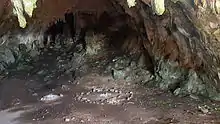Corycian Cave
The Corycian Cave (/kəˈrɪʃən/; Greek: Κωρύκιον ἄντρον, romanized: Kōrykion antron)[1] is located on the slopes of Mount Parnassus, in central Greece. In the mythology of the area, it is named after the nymph Corycia; however, its name etymologically derives from korykos, "knapsack". A modern name for the cave in some references is Sarantavli, meaning "forty rooms". This cave was sacred to the Corycian nymphs and the Muses, and a place of worship for Pan.

Traditionally the cave has been a place of refuge for the surrounding population during foreign invasions e.g. from the Persians (Herodotus, 8.36) in the 5th century BC, the Turks during the Greek War of Independence, and from the Germans in 1943.
History

Strabo, in his Geography, writes:
The whole of Parnassos [Mountain in Phokis] is esteemed as sacred [to Apollon], since it has caves and other places that are held in honor and deemed holy. Of these the best known and most beautiful is Korykion, a cave of the Nymphai bearing the same name as that in Kilikia [in Asia Minor]. (9.3.1)
An excavation by French archaeologists in 1969 produced a plethora of objects of antiquity including a rare Neolithic male figurine, Mycenean shards, bone flutes, iron and bronze rings, miniature bronze statues, 50,000 terracotta figurines from the classical period and 24,000 astragaloi, or "knucklebones" (used for astragalomancy, or "prophecy by knucklebones").
King Otto and Queen Amalia made a royal tour with 100 torchbearers to view the two chambers of the cavern which is enormous at 60 m long, 26 m wide and 12 m high.
Pausanias in his Guide to Greece writes:
On the way from Delphi to the summit of Parnassus, about sixty stades distant from Delphi, there is a bronze image. The ascent to the Corycian cave is easier for an active walker than it is for mules or horses. I mentioned a little earlier in my narrative that this cave was named after a nymph called Corycia, and of all the caves I have ever seen this seemed to me the best worth seeing.... But the Corycian cave exceeds in size those I have mentioned, and it is possible to make one's way through the greater part of it even without lights. The roof stands at a sufficient height from the floor, and water, rising in part from springs but still more dripping from the roof, has made clearly visible the marks of drops on the floor throughout the cave. The dwellers around Parnassus believe it to be sacred to the Corycian nymphs, and especially to Pan. (10.32.2–7)
References
External links
| Wikimedia Commons has media related to Korykian Cave above Delphi. |
- Κωρύκιο Άντρο Korykio Antro or Pan's Cave
- Korykian Cave in the Princeton Encyclopedia of Classical Sites
- Delphi: The Bellybutton of the Ancient World. BBC 4. Michael Scott. 10:48 minutes in. Retrieved 23 November 2010.CS1 maint: others (link)